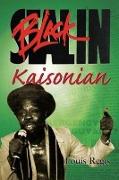Black Slain Kaisonian
BücherAngebote / Angebote:
Black Stalin: Kaisonian examines the career of the veteran calypso composer/ performer of Trinidad and Tobago. Stalin entered the calypso gayelle in 1959 and has been active there since then. The book traces in the socio-economic circumstances of his upbringing, the genesis of the abiding themes of his career-long Calypso. Being born into poverty in San Fernando, the town South Trinidad which boasts itself the industrial capital of the Trinidad, Stalin's youthful inward hunger generated that permanent interest in Trinidad¹s underclass who among whom one finds disproportionate numbers of Afro-Trinidadians. His abiding love for the expressive culture of the urban Afro-Trinidadian underclass is also rooted in this experience of growing up in the milieu of Black working class San Fernando where Calypso, the Steelband and mas¹ were the dominant artistic cultural practices. Although Stalin¹s Calypso has been shaped by national and international affairs and movements, it remains informed by and centred upon the issues deriving from the circumstances of his childhood and upbringing. Given this and his own deeply-ingrained for tradition, is it no wonder that Stalin chose the vocation of calypsonian even though the status of calypsonians enjoyed at best ambivalent status even among Trinidad and Tobago¹s proletariat. He embarked upon this career enthusiastically and slowly achieved national and international success and acclaim. Black Stalin: Kaisonian traces Stalin¹s development from apprenticeship at the South tent, his entry into Port of Spain and his encounter with Sparrow, his withdrawal, his tutelage under Tiger and Unknown, his subsequent reentry and acknowledging of Kitchener as mentor, his interaction with other emerging singers and finally his own emergence as patron and inspiration to a younger generation of singer. Along the way the book examines the issue of smut¹ in Calypso and the soca controversy of the late 70s and early 80s. In this way it provides insider insights into calypso practice, the operations of the industry, and the tangle of personal and professional relationships in the volatile community of calypso singers. Black Stalin: Kaisonian thus aims to be first calypso book to profile a calypsonian, discuss his work as expressions of his world view, and locate his work within the currents of the ever-shifting entertainment industry in general and of the calypso industry in particular. Of particular significance in this regard is the interview of 1985 which is presented as an appendix. This interview illumines the workings of Stalin¹s mind with respect to the Steelband and it allows readers to glimpse the creative process by which long-meditated thoughts are transformed into calypso. Interviews with Stalin conducted over several years constitute the major source of information for this book but this source of information is corroborated by personal observation, information gleaned from discussions with others and by information freely available in the public domain. Newspaper articles fill in the lacuna in Stalin¹s memory, especially where the forgotten material subverts the image he has invented for himself. Adding to the particular appeal of the book are the large collection of song lyrics.
Folgt in ca. 15 Arbeitstagen
